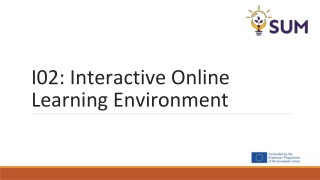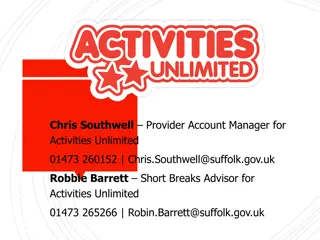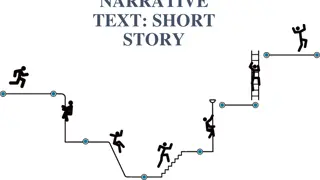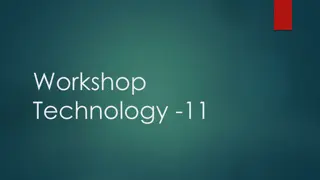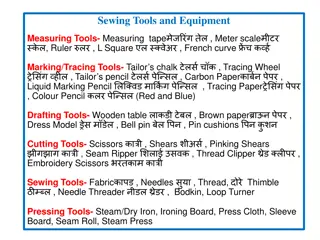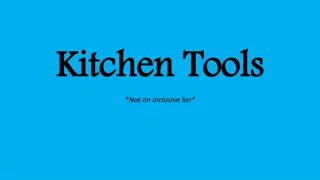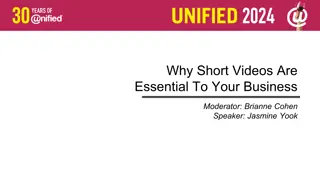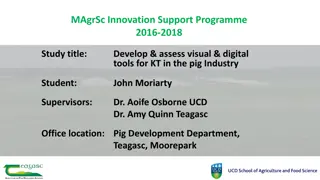
Enhancing Teaching with Online Tools: Strategies and Recommendations
Explore the evolution of online tools, the importance of adapting to new technologies in education, considerations for choosing the right tools, and a breakdown of popular tools like calendars and scheduling aids. Understand the shift from Web 1.0 to Web 3.0, and learn about best practices for incorporating technology effectively into teaching practices.
Download Presentation

Please find below an Image/Link to download the presentation.
The content on the website is provided AS IS for your information and personal use only. It may not be sold, licensed, or shared on other websites without obtaining consent from the author. If you encounter any issues during the download, it is possible that the publisher has removed the file from their server.
You are allowed to download the files provided on this website for personal or commercial use, subject to the condition that they are used lawfully. All files are the property of their respective owners.
The content on the website is provided AS IS for your information and personal use only. It may not be sold, licensed, or shared on other websites without obtaining consent from the author.
E N D
Presentation Transcript
Online Tools /52 1
A moving target Tools change, versions updated. Before you know it or before you use it has changed. /52 2
The good thing Teachers who incorporate new tools are perceived to be cutting-edge. /52 3
Warning Must be part of the instructional design Not just a cool thing to add to your teaching /52 4
Web 1.0, Web 2.0, Web 3.0 Web 1.0 = reading as consumer Web 2.0 = contributing as a producer Web 3.0 = semantic web , personalized web (the content changes based on your personal needs, interests, abilities) /52 6
What factors to consider in choosing a tool Matches with your teaching style Choose a tool that solves a problem not the one that creates a problem Platform- Some tools are good only for online or only for f2f Best practices- Best used for what? Cost Accessibility /52 7
Tools /52 8
1- Organize Calendars Scheduling aids Mind mapping Social bookmarking /52 9
Calendars Google Calendar 30boxes.com You can share your calendar with your students You can sync it with your Outlook and your mobile phone /52 10
Google Calendar /52 11
30Boxes /52 12
Scheduling tools An easy way to find out when everyone is free for your next meeting or event. Doodle = free http://doodle.com Whenisgood =free http://whenisgood.net Timetrade http://www.timetrade.com = free trial (Online Appointment Scheduling) /52 13
Mind mapping tools Organize and represent information graphically http://bubbl.us = online-free http://www.text2mindmap.com = online-free www.mywebspiration.com = free trial= web version of Inspiration www.mindmeister.com = free trial = $ 5 /month /52 14
Social Bookmarking Accessto your bookmarks from anywhere Shareyour bookmarks with others Let your colleagues add to your bookmarks Highlightand Add sticky notes on web pages Archivepages forever and make them searchable, too Organize your items by tags or lists /52 15
Examples https://delicious.com/ www.diigo.com /52 16
Diigo /52 17
Note Sharing NoteShare Express - Desktop Edition See the videos http://www.aquaminds.com/nsDesktopProduc t.jsp /52 18
Note Taking Note taker http://www.aquaminds.com/product.jsp Apple Note Taker http://itunes.apple.com/us/app/note-taker/id342284707?mt=8 /52 19
Mobile Note Taker (iNote) /52 20
Note Taker HD /52 21
Virtual Storage and file Management Upload files to a secure server Free (for small size) www.drivehq.com (cloud) www.fileden.com www.yousendit.com www.dropbox.com /52 22
2 Tools to communicate and collaborate /52 23
Discussion Forums For an online and hybrid course the heart and soul of the course is communication Text Ning Yahoo Groups Google Groups Voice http://voicethread.com = free small size www.wimba.com/products/wimba_voice = institutional subscription www.bigbluebutton.org= Free , institutional subscription /52 24
Instant Messaging It is most appropriate for quick questions that do not require lengthy explanations. Also you may use it as an assessment tool or as an educational game tool. SMS (Short Message Srvice) Google Chat Yahoo Messenger AOL Instant Messenger /52 25
Blogs Allows readers to add comments. Students get feedback on their writing www.blogger.com http://edublog.com http://wordpress.com /52 26
VoIP (Voice over Internet Protocol) Converts sound from analog to digital and sends it over the Internet. Google talk / see video www.tinychat.com (up to 10 simultaneous calls) Tango (cell phones) Viber (cell phones) /52 27
Wikis A wiki page allows a group of users to update and edit text collaboratively. http://www.wikispaces.com http://pbworks.com Googledocs /52 28
Microblogs (Tweets) Microblogging is the practice of communicating brief ideas as digital content to an audience. The content is limited to 100-140 words Can be sent or received through a computer or cell phone Might be the against our goal of scholarly writing. /52 29
Microblogs (Tweets) www.twitter.com www.tumblr.com www.edmodo.com /52 30
Web Conferencing Students enrolled in online courses, sometimes report feeling disconnected or socially isolated. CSULB Elluminate/Collaborate Google Hangout / see Video Skype Adobe Connect Dimdin http://vyew.com /52 31
3- Tools to Present Content /52 32
Importance of audio Audio and the power of human voice humanize the learning experience There are some content that can only come in audio format (music, spoken language, sound effects) /52 33
Audio Tools Audacity (http://audacity.sourceforge.net ) Garage Band (Mac Only) (www.apple.com/ilife/garageband ) Mixcraft http://www.acoustica.com/mixcraft Propaganda (www.makepropaganda.com) Sony Acid Music Studio http://www.sonycreativesoftware.com/musicstu dio /52 34
Video Captioning Video iMovie (Mac) iDVD (Mac) Windows Live Movie Maker Distributing Video YouTube TeacherTube Scholastic TeacherShare /52 35
Screencasting Screen shot = Still image of computer screen Screen Capturing = Recording exactly what happens on computer screen as a video file Screencasting = Publishing (usually live with narration) what is happening on computer screen /52 36
Screencasting Jing Camtasia Captivate Screenflow /52 37
Narrated Slide Show Prevents the instructor from cluttering the screen with small text or assuming the students ability to understand the full meaning behind a few bulleted phrase. /52 38
Narrated Slide Show Powerpoint Keynote (Mac) Yodio Flash http://prezi.com/ (hard to do narration) /52 39
Sharing Images http://instagram.com Flickr Picasa Photobucket /52 40
4- Tools to assess learning /52 41
Quizzes, Tests, and Surveys https://quizlet.com Google Forms http://qualtrics.com/ ProProfs Quiz School Quia SurveyMonkey Zoomrang /52 42
Rubrics and Matrixes Often, instructors, give a brief narrative description of an assignment without fully explaining how it will be graded. Rubristar (http://rubristar.4teachers.org ) Rubric Builder (www.rubricbuilder.on.ca ) TaskStream (Institutional subscription) /52 43
E-Portfolio Assessment should not be the sole responsibility of the instructor. Students should also participate in the assessment process through self-assessment and reflection. /52 44
E-Portfolio Helps the instructor to know What students have completed (performed) before your class. What they already know? How much have they grown in the specific content area? How is their overall progress in your program. /52 45
E-Portfolio Tools www.eportfolio.org http://mahara.org www.pupilpages.com TaskStream (Institutional subscription) /52 46
5- Tools to help you transform your Identity /52 47
Avatars Avatars are animated characters that you can add to web pages as a way of bringing a more personal , visual , and human element to your messages. CodeBaby www.codebaby.com see video SitePal http://sitepal.com Voki www.voki.com (can create a post to your Facebook) /52 48
Virtual Worlds Places on the Web that can either emulate our physical world or represent fantasy A more realistic way of communication and collaboration Used in autism, language learning, art gallery, internal design. /52 49
Virtual World Tools Quest Atlantis http://atlantisremixed.org Fantage www.fantage.com Reaction Grid www.reactiongrid.com Second Life http://secondlife.com (Scroll down) /52 50



